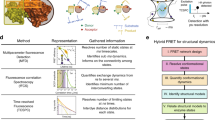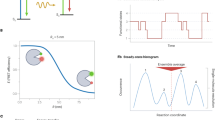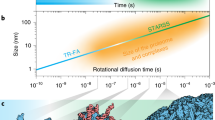Abstract
Kramers developed the theory on how chemical reaction rates are influenced by the viscosity of the medium1,2. At the viscosity of water, the kinetics of unimolecular reactions are described by diffusion of a Brownian particle over a free-energy barrier separating reactants and products. For reactions in solution this famous theory extended Eyring’s transition state theory, and is widely applied in physics, chemistry and biology, including to reactions as complex as protein folding3,4. Because the diffusion coefficient of Kramers’ theory is determined by the dynamics in the sparsely populated region of the barrier top, its properties have not been directly measured for any molecular system. Here we show that the Kramers diffusion coefficient and free-energy barrier can be characterized by measuring the temperature- and viscosity-dependence of the transition path time for protein folding. The transition path is the small fraction of an equilibrium trajectory for a single molecule when the free-energy barrier separating two states is actually crossed. Its duration, the transition path time, can now be determined from photon trajectories for single protein molecules undergoing folding/unfolding transitions5. Our finding of a long transition path time with an unusually small solvent viscosity dependence suggests that internal friction as well as solvent friction determine the Kramers diffusion coefficient for α-helical proteins, as opposed to a breakdown of his theory, which occurs for many small-molecule reactions2. It is noteworthy that the new and fundamental information concerning Kramers’ theory and the dynamics of barrier crossings obtained here come from experiments on a protein rather than a much simpler chemical or physical system.
This is a preview of subscription content, access via your institution
Access options
Subscribe to this journal
Receive 51 print issues and online access
$199.00 per year
only $3.90 per issue
Buy this article
- Purchase on Springer Link
- Instant access to full article PDF
Prices may be subject to local taxes which are calculated during checkout




Similar content being viewed by others
References
Kramers, H. A. Brownian motion in a field of force and the diffusion model of chemical reactions. Physica 7, 284–304 (1940)
Hänggi, P., Talkner, P. & Borkovec, M. Reaction rate theory; fifty years after Kramers. Rev. Mod. Phys. 62, 251–341 (1990)
Oliveberg, M. & Wolynes, P. G. The experimental survey of protein-folding energy landscapes. Q. Rev. Biophys. 38, 245–288 (2005)
Kubelka, J., Henry, E. R., Cellmer, T., Hofrichter, J. & Eaton, W. A. Chemical, physical, and theoretical kinetics of an ultrafast folding protein. Proc. Natl Acad. Sci. USA 105, 18655–18662 (2008)
Chung, H. S., McHale, K., Louis, J. M. & Eaton, W. A. Single-molecule fluorescence experiments determine protein folding transition path times. Science 335, 981–984 (2012)
Chung, H. S. et al. Extracting rate coefficients from single-molecule photon trajectories and FRET efficiency histograms for a fast-folding protein. J. Phys. Chem. A 115, 3642–3656 (2011)
Lindorff-Larsen, K., Piana, S., Dror, R. O. & Shaw, D. E. How fast-folding proteins fold. Science 334, 517–520 (2011)
Gopich, I. V. & Szabo, A. Decoding the pattern of photon colors in single-molecule FRET. J. Phys. Chem. B 113, 10965–10973 (2009)
Chung, H. S., Louis, J. M. & Eaton, W. A. Experimental determination of upper bound for transition path times in protein folding from single-molecule photon-by-photon trajectories. Proc. Natl Acad. Sci. USA 106, 11837–11844 (2009)
Chung, H. S., Cellmer, T., Louis, J. M. & Eaton, W. A. Measuring ultrafast protein folding rates from photon-by-photon analysis of single molecule fluorescence trajectories. Chem. Phys. 422, 229–237 (2013)
Hummer, G. From transition paths to transition states and rate coefficients. J. Chem. Phys. 120, 516–523 (2004)
Socci, N. D., Onuchic, J. N. & Wolynes, P. G. Diffusive dynamics of the reaction coordinate for protein folding funnels. J. Chem. Phys. 104, 5860–5868 (1996)
Klimov, D. K. & Thirumalai, D. Viscosity dependence of the folding rates of proteins. Phys. Rev. Lett. 79, 317–320 (1997)
Best, R. B. & Hummer, G. Reaction coordinates and rates from transition paths. Proc. Natl Acad. Sci. USA 102, 6732–6737 (2005)
Cellmer, T., Henry, E. R., Hofrichter, J. & Eaton, W. A. Measuring internal friction of an ultrafast-folding protein. Proc. Natl Acad. Sci. USA 105, 18320–18325 (2008)
Kubelka, J., Hofrichter, J. & Eaton, W. A. The protein folding ‘speed limit’. Curr. Opin. Struct. Biol. 14, 76–88 (2004)
Yang, W. Y. & Gruebele, M. Folding at the speed limit. Nature 423, 193–197 (2003)
Hummer, G. & Szabo, A. Free energy surfaces from single-molecule force spectroscopy. Acc. Chem. Res. 38, 504–513 (2005)
Godoy-Ruiz, R. et al. Estimating free-energy barrier heights for an ultrafast folding protein from calorimetric and kinetic data. J. Phys. Chem. B 112, 5938–5949 (2008)
Portman, J. J., Takada, S. & Wolynes, P. G. Microscopic theory of protein folding rates. II. Local reaction coordinates and chain dynamics. J. Chem. Phys. 114, 5082–5096 (2001)
Makarov, D. E. Interplay of non-Markov and internal friction effects in the barrier crossing kinetics of biopolymers: insights from an analytically solvable model. J. Chem. Phys. 138, 014102 (2013)
Schulz, J. C. F., Schmidt, L., Best, R. B., Dzubiella, J. & Netz, R. R. Peptide chain dynamics in light and heavy water: zooming in on internal friction. J. Am. Chem. Soc. 134, 6273–6279 (2012)
Ansari, A., Jones, C. M., Henry, E. R., Hofrichter, J. & Eaton, W. A. The role of solvent viscosity in the dynamics of protein conformational changes. Science 256, 1796–1798 (1992)
Soranno, A. et al. Quantifying internal friction in unfolded and intrinsically disordered proteins with single-molecule spectroscopy. Proc. Natl Acad. Sci. USA 109, 17800–17806 (2012)
Bryngelson, J. D. & Wolynes, P. G. Intermediates and barrier crossing in a random energy-model (with applications to protein folding). J. Phys. Chem. 93, 6902–6915 (1989)
Zagrovic, B. & Pande, V. Solvent viscosity dependence of the folding rate of a small protein: distributed computing study. J. Comput. Chem. 24, 1432–1436 (2003)
Sutto, L., Latzer, J., Hegler, J. A., Ferreiro, D. U. & Wolynes, P. G. Consequences of localized frustration for the folding mechanism of the IM7 protein. Proc. Natl Acad. Sci. USA 104, 19825–19830 (2007)
Jas, G. S., Eaton, W. A. & Hofrichter, J. Effect of viscosity on the kinetics of α-helix and β-hairpin formation. J. Phys. Chem. B 105, 261–272 (2001)
Wensley, B. G. et al. Experimental evidence for a frustrated energy landscape in a three-helix-bundle protein family. Nature 463, 685–688 (2010)
Hagen, S. J. Solvent viscosity and friction in protein folding dynamics. Curr. Protein Pept. Sci. 11, 385–395 (2010)
Merchant, K. A., Best, R. B., Louis, J. M., Gopich, I. V. & Eaton, W. A. Characterizing the unfolded states of proteins using single-molecule FRET spectroscopy and molecular simulations. Proc. Natl Acad. Sci. USA 104, 1528–1533 (2007)
Vogelsang, J. et al. A reducing and oxidizing system minimizes photobleaching and blinking of fluorescent dyes. Angew. Chem. 47, 5465–5469 (2008)
Benninger, R. K. P. et al. Quantitative 3D mapping of fluidic temperatures within microchannel networks using fluorescence lifetime imaging. Anal. Chem. 78, 2272–2278 (2006)
Viterbi, A. J. Error bounds for convolution codes and an asymptotically optimum decoding algorithm. IEEE Trans. Inf. Theory 13, 260–269 (1967)
Rabiner, L. R. A tutorial on hidden Markov models and selected applications in speech. Proc. IEEE 77, 257–286 (1989)
Best, R. B., Hummer, G. & Eaton, W. A. Native contacts determine protein folding mechanisms in atomistic simulations. Proc. Natl Acad. Sci USA http://dx.doi.org/10.1073/pnas.1311599110 (in the press)
Zhu, Y. et al. Ultrafast folding of α3D: a de novo designed three-helix bundle protein. Proc. Natl Acad. Sci. USA 100, 15486–15491 (2003)
Liu, F. et al. A one-dimensional free energy surface does not account for two-probe folding kinetics of protein α3D. J. Chem. Phys. 130, 061101 (2009)
Acknowledgements
We are particularly indebted to J. M. Louis for the preparation, dye labelling and purification of the protein used in this work, with technical assistance from A. Aniana. We also thank R. Best, G. Hummer and A. Szabo for discussions and comments on the manuscript, and D.E. Shaw Research for providing access to their molecular dynamics trajectories for the calculations by R. Best. This work was supported by the Intramural Research Program of the National Institute of Diabetes and Digestive and Kidney Diseases, National Institutes of Health.
Author information
Authors and Affiliations
Contributions
H.S.C. and W.A.E. designed the research and wrote the manuscript; H.S.C. collected and analysed the experimental data.
Corresponding authors
Ethics declarations
Competing interests
The authors declare no competing financial interests.
Extended data figures and tables
Extended Data Figure 1 Amino acid sequences of polypeptides containing protein α3D.
Dyes were attached to the cysteine residues (red) and a biotin molecule was attached to the lysine residue (blue) in the AviTag sequence.
Extended Data Figure 2 Photon trajectory and kinetics models.
a, The definition of photon indices and time interval of a photon trajectory with a folding transition. b, c, Photon trajectories were analysed using the two-state model to determine kinetics parameters (b) or the three-state model to determine the average transition path times (tTP = 1/2kS) (c).
Extended Data Figure 3 FRET efficiency histograms of α3D in 2.25 M GdmCl solution at different temperatures.
The FRET efficiency histograms were constructed from 1-ms bins in the trajectories with the mean photon count rate >40 ms−1. Wide and narrow bars are the experimental histograms and the histograms constructed from re-coloured photon trajectories using the parameters obtained from the maximum likelihood method with the two-state model (Extended Data Table 1), respectively. The agreement between the two histograms validates the description of α3D as a two-state folder8. The similar ratio of the integral of the folded (high FRET) and the unfolded (low FRET) distributions indicates that the equilibrium constant is unchanged over the temperature range of the measurement, as shown more precisely in the maximum likelihood analysis. At high temperature and low pH, where the 11 glutamates and 1 aspartate are protonated, more than two states are observed37,38.
Extended Data Figure 4 Donor–acceptor cross-correlation functions at different temperatures.
Black solid lines are exponential functions that best fit the data. The fitting parameters are listed in Extended Data Table 1.
Extended Data Figure 5 FRET efficiency histograms of α3D at various solvent viscosities.
The FRET efficiency histograms were constructed from 1-ms bins in the trajectories with the mean photon count rate >50 ms−1 for 2.25 M and 3.2 M GdmCl and from 2-ms bins in the trajectories with the mean photon count rate >30 ms−1 for 4.6 M, 4.3 M and 3.8 M GdmCl concentrations. At the relative viscosity (η/η0) 1, 10 and 38, the higher concentration of GdmCl was used to counteract the stabilization of proteins by glycerol to maintain the ratio of folded to unfolded molecules as close to unity as practically possible. The similar ratio of the integral of the folded (high FRET) and the unfolded (low FRET) distributions indicates that the equilibrium constant is unchanged at these conditions, as shown more precisely in the maximum likelihood analysis.
Extended Data Figure 6 Donor–acceptor cross-correlation of the segments of the fluorescence trajectories corresponding to the unfolded state (ref. 24).
a, Black solid lines are exponential functions that best fit the data. The fitting parameters are listed in Extended Data Table 2. b, The unfolded state dynamics are slowed approximately linearly by the solvent viscosity as previously observed at high denaturant concentrations24. The relaxation time at η/ η0 = 1 (aqueous solution) is too fast to be measured by this method.
Rights and permissions
About this article
Cite this article
Chung, H., Eaton, W. Single-molecule fluorescence probes dynamics of barrier crossing. Nature 502, 685–688 (2013). https://doi.org/10.1038/nature12649
Received:
Accepted:
Published:
Issue Date:
DOI: https://doi.org/10.1038/nature12649
This article is cited by
-
Learning non-stationary Langevin dynamics from stochastic observations of latent trajectories
Nature Communications (2021)
-
Transition path times of coupled folding and binding reveal the formation of an encounter complex
Nature Communications (2018)
-
Diffusion-limited association of disordered protein by non-native electrostatic interactions
Nature Communications (2018)
-
Structural Dynamics of the GW182 Silencing Domain Including its RNA Recognition motif (RRM) Revealed by Hydrogen-Deuterium Exchange Mass Spectrometry
Journal of the American Society for Mass Spectrometry (2018)
-
A star-shaped DNA probe based on strand displacement for universal and multiplexed fluorometric detection of genetic variations
Microchimica Acta (2018)
Comments
By submitting a comment you agree to abide by our Terms and Community Guidelines. If you find something abusive or that does not comply with our terms or guidelines please flag it as inappropriate.



